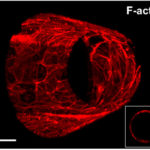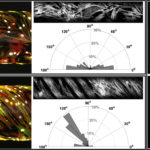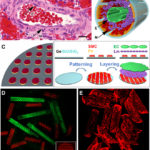Biomimetic human small muscular pulmonary arteries
Changes in structure and function of small muscular arteries play a major role in the pathophysiology of pulmonary hypertension, a burgeoning public health challenge. Improved anatomically mimetic in vitro models of these microvessels are urgently needed because nonhuman vessels and previous models do not accurately recapitulate the microenvironment and architecture of the human microvascular wall. Here, we describe parallel biofabrication of photopatterned self-rolled biomimetic pulmonary arterial microvessels of tunable size and infrastructure. These microvessels feature anatomically accurate layering and patterning of aligned human smooth muscle cells, extracellular matrix, and endothelial cells and exhibit notable increases in endothelial longevity and nitric oxide production. Computational image processing yielded high-resolution 3D perspectives of cells and proteins. Our studies provide a new paradigm for engineering multicellular tissues with precise 3D spatial positioning of multiple constituents in planar moieties, providing a biomimetic platform for investigation of microvascular pathobiology in human disease.
Learn about our two Decals!
 Click here to find out more about our Fall Bioinspired Design Decal and our Spring Bioinspired Design in Action Decal – ALL MAJORS are welcome.
Click here to find out more about our Fall Bioinspired Design Decal and our Spring Bioinspired Design in Action Decal – ALL MAJORS are welcome.Berkeley BioDesign Community
 Click here to learn about the BioD: Bio-Inspired Design @ Berkeley student organization or here to signup for more info.
Click here to learn about the BioD: Bio-Inspired Design @ Berkeley student organization or here to signup for more info.Search
Student Login






I imagine that the neurological circuits underlying these processes are governed by both 2d spacing maps with their brains as…
to reduce the impact of car accidents, it may be possible to study the force diverting physics of cockroaches to…
you see this type of head-bobbing stability in many avian creatures related to pigeons like chickens. the head ability to…
not like they taught horses how to run! this is an example of convergent evolution where both sea creatures and…
The brain functions in a similar way with neuronal connections. our brains are able to utilize the multiplicity of connections…